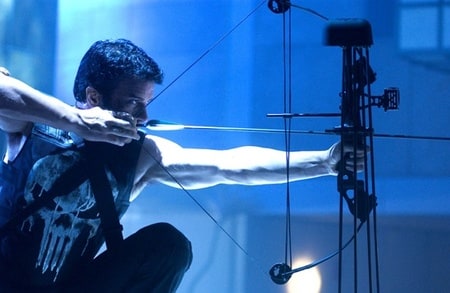Bunraku is one big mishmash of several different genres, with writer-director Guy Moshe sourcing elements from samurai films, gangster pictures, spaghetti westerns, Hong Kong martial arts flicks, graphic novels, pulp exploitation films, musicals, and anime. It's an interesting concoction, and the result is frequently ravishing to behold thanks to the impressive collaborators that Moshe recruited, including production designer Alex McDowell (Watchmen, Corpse Bride), who co-produced, and Oscar-winning editor Zach Staenberg (The Matrix, Lord of War). Yet, despite the impressive technical accomplishments, Bunraku fails to hold together as a coherent whole. Its narrative is dull and empty, not to mention the characters are downright boring and it's overlong at two hours.

In a post-apocalyptic future, guns are outlawed, and swords are king. In a Shanghai-like town, tyrant Nicola the Woodcutter (Ron Perlman) is a vicious crime boss, employing his gang of assassins led by the flamboyant Killer No. 2 (Kevin McKidd) to keep citizens under his rule. Into the town steps The Drifter (Josh Hartnett), a shadowy, no-nonsense cowboy type. Also on the streets is Japanese warrior Yoshi (Gackt), who wants to keep his family safe and take down Nicola. With the help of a mysterious bartender (Woody Harrelson), The Drifter and Yoshi join forces, hoping to conquer Nicola.
Bunraku represents another attempt at translating graphic novel sensibilities to cinema, using CGI and green screen to create a unique look. It's a well-made motion picture, with the set design perfectly capturing the feel of anime and comic books. Moshe also deploys various interesting camera angles and visual gimmicks, such as speech bubbles and drop-down tags identifying Nicola's henchmen. There's so much to absorb in every shot, with lots of colour, editorial flourishes and extravagant costuming. Bunraku looks phenomenal; this universe is utterly original and was brought to the screen with an incredible amount of aesthetic detail. Moshe was even inspired by classic musicals like West Side Story, most evident in a stylish opening sequence depicting a violent battle between two gangs that plays out like a dance number. However, Moshe's armoury of filmmaking techniques grows thin quickly, and momentum soon flags due to the drab nature of the narrative.

Other, superior movies similarly achieve astonishing visuals, but those films have colourful characters and interesting, coherent stories to tell. Bunraku, on the other hand, doesn't have much story to tell and features a bland cast of caricatures. Thus, while there is plenty of activity here, it's not overly coherent despite constant narration meant to try and keep the plot intact. Bunraku didn't make much sense to me, though it was probably my boredom with the interminable feature that clouded my ability to properly follow the story's progressions. Still, Moshe deserves criticism for his storytelling; the monotony and lack of brevity are a considerable problem, the dialogue is dreary, and it takes too long for the climax to arrive. Bunraku is driven by its fight sequences, but they lack any punch due to the boring in-between stuff and the lack of investment in anything that occurs.
The cast is a mixed bag, as well. Perlman is frequently impressive as the villain, displaying a solid amount of menace and thoughtfulness. Likewise, Kevin McKidd is a scene-stealer as Killer No. 2, displaying ample charm, panache and flamboyance. McKidd is so enjoyable to watch that it's a shame he's not a hero here. Also good is Harrelson, who is having a blast as the bartender. The rest of the actors, alas, are less impressive. Hartnett is outright boring as The Drifter; he lacks charm, and he shares no chemistry with his co-star Gackt, who's just as bland. Even Demi Moore is flat, to the extent that it never registers that she's even in the movie.

It's easy to admire the technical construction of the picture, but it's challenging to get through a single viewing of Bunraku, as it continually tests your patience. Thus, while it deserves credit for its ambition and a few isolated elements, it's a misfire.
4.8/10
 Login
Login
 Home
Home 183 Lists
183 Lists 1668 Reviews
1668 Reviews Collections
Collections
 0 comments,
0 comments, 


































